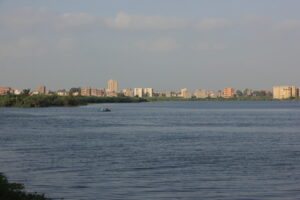Fuwwah
Fuwwah is a UNESCO world heritage site, which lies on the Western Nile branch (Rosetta). Its name, in Arabic, is the name of a plant that is known for its rose pigment used in dyeing clothes and fezzes. Fuwwah’s population is roughly 65,000. It houses a huge number of Islamic monuments, mosques, Sufism buildings, and commercial buildings. But few people are aware that it has many other monuments that are well worth visiting.
Fuwwah and Rosetta exchanged their importance because of their locations between the Mediterranean and the Western Branch of the Nile, both are considered the most flourishing Mediterranean harbors.
The history of Fuwwah dates back to the Pharaonic era, during which it was the capital of the 7th province of Lower Egypt. In the Greek Era, it was called Mitlis, which means the city of the foreigners, referring to the Greeks who migrated to the West of the Nile Delta during the end of the Pharaonic Era.
Apart from the historical and architectural importance of Fuwwah, it’s famous for ‘kleem’ the famous Egyptian handmade carpet made of cheap wool. Many workshops still produce floor tiles using the old techniques. Those attractions are hard to miss, as they are almost around every street corner.
Fuwwah is also famous for its local market and fishing community. In Fuwwah, the fishermen’s houses are clustered around the Nile Branch Bank, and the best way to view it is from a motorboat or a small oar boat on a short trip on The Nile.
What to see:
The Mosques of Fuwwah are characterized by the red bricks they are built with, which are coloured by the Nile Silt. Sometimes, the bricks are alternately red and black, and they also used white between courses, with stepped crenellations at the top of walls, like the hanging Mamluk Mosque of Al-Qinani, which has the best pulpit all over Fuwwah, and the Ottoman Mosque of Abu-Almakarm.
During the 15th Century, Prince Hassan Nasr-Allah was born and brought up for a time in Fuwwah, where he studied mathematics and The Qur’an. He was extraordinarily smart, and the governor of the town sent him to study in Cairo and eventually go to Al-Azhar University. He joined the Madrasa of Sultan Hussain, one of the greatest at the time. However, he did not join Al-Azhar University, but instead served in various governmental positions, including the minister of the army. During the reign of Sultan Al-Ashraf Bersbay, he was accused of embezzlement, and his money was confiscated, so he made a vow that if he got acquitted, he would build a mosque in his birthplace. God fulfilled his wish, and he built the Madrasa and Mosque of Prince Hassan Nasr-Allah.
Al-Tikiya Al-Khalawatiya once served as the residence place for the Sufis; the word ‘khalawatiya’ is the name of one of the Sufi groups. It was the only existing example in The Delta and it was ruined and rebuilt. It has bedrooms, study rooms, and a mosque.
Rabaa Al-Khatiba is an inn for caravanserais and merchants inn who came to sell their products in Fuwwah. It has three floors: the ground floor contains the storage rooms and the stables, the first floor contains bedrooms, bathrooms, and kitchens, and the third floor was the place where the merchants would have been entertained by groups of musicians.
In 1824, Muhammad Ali ordered the governor of Fuwwah to build a factory for fezzes; The gates of the factory still stand today. He started to construct the factory and an expert from Tunisia supervised the construction. In 1837, the daily production reached 120 fezzes. The production covered the needs of Egypt and fezzes were exported to various countries. During excavations, some molds that were used to shape the fezzes were unearthed and are now preserved in the Tanta Museum, but the factory is long gone now.
if you are interested in Egypt’s modern history, a tour of these workshops is a great learning experience

